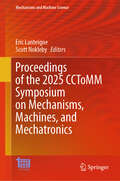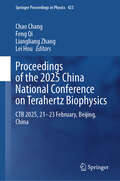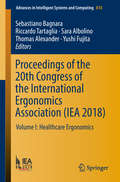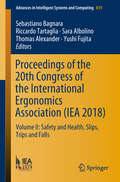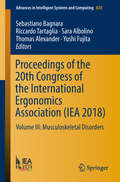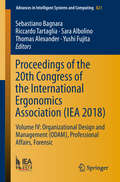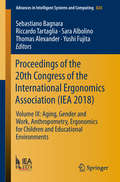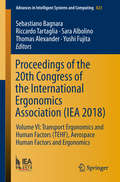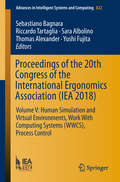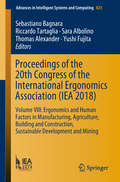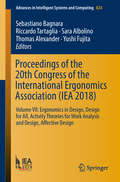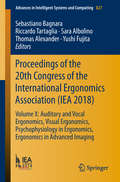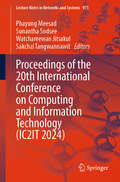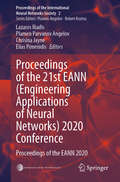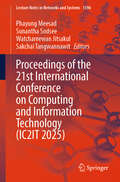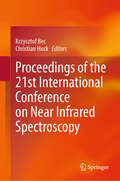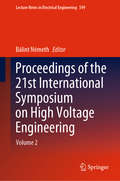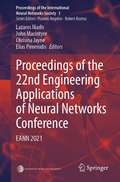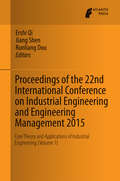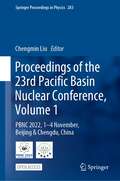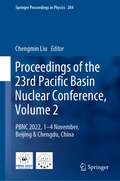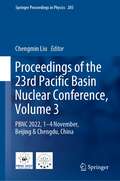- Table View
- List View
Proceedings of the 2025 CCToMM Symposium on Mechanisms, Machines, and Mechatronics (Mechanisms and Machine Science #184)
by Eric Lanteigne Scott NoklebyThis book gathers the latest fundamental research contributions, innovations, and applications in the field of robotic mechanical systems, machines, and mechanisms, as presented by leading researchers at the 13th CCToMM Symposium on Mechanisms, Machines, and Mechatronics (2025 CCToMM M^3 Symposium), held in Ottawa, Canada on June 19-20, 2025. It covers highly diverse topics, including soft, wearable and origami robotic systems; applications to walking, flying, climbing, underground, swimming and space systems; human rehabilitation and performance augmentation; design and analysis of mechanisms and machines; human-robot collaborative systems; service robotics; mechanical systems and robotics education; and the commercialization of mechanical systems and robotics. The contributions, which were selected by means of a rigorous international peer-review process, highlight numerous exciting and impactful research results that will inspire novel research directions and foster multidisciplinary research collaborations among researchers from around the globe.
Proceedings of the 2025 China National Conference on Terahertz Biophysics: CTB 2025, 21–23 February, Beijing, China (Springer Proceedings in Physics #423)
by Feng Qi Lei Hou Chao Chang Liangliang ZhangThis book highlights reviews, perspectives, and original research that contribute to the advanced interdisciplinary studies of theories, technologies, and strategies on THz sensing, biophysics, communications, and bio-effect research. The terahertz (THz) frequency covers a spectrum important for applications such as body security, non-destructive matter sensing, bio-imaging, and bio-medicine. It overlaps with the characteristic fingerprints of molecular vibrations and rotations (e.g., proteins and DNA) and thus could resonantly interact with various bio-matters. The 2021 Nobel Prize in medicine was granted for the discovery of ion channels of temperature and pressure sensing. The frequency of THz makes it absorbable for bio-effect and modulation of bio-molecules, especially for ion channels. Besides, the high-speed modulation in terahertz is a holy grail for integrated photonics in high-capacity computations. This topic has raised widespread interest in fundamental science and applications for THz. The proceedings are suitable for researchers and students interested in interdisciplinary research at the intersection of electromagnetics, physics, and life sciences.
Proceedings of the 20th Congress of the International Ergonomics Association: Volume I: Healthcare Ergonomics (Advances in Intelligent Systems and Computing #818)
by Thomas Alexander Sebastiano Bagnara Riccardo Tartaglia Sara Albolino Yushi FujitaThis book presents the proceedings of the 20th Congress of the International Ergonomics Association (IEA 2018), held on August 26-30, 2018, in Florence, Italy. By highlighting the latest theories and models, as well as cutting-edge technologies and applications, and by combining findings from a range of disciplines including engineering, design, robotics, healthcare, management, computer science, human biology and behavioral science, it provides researchers and practitioners alike with a comprehensive, timely guide on human factors and ergonomics. It also offers an excellent source of innovative ideas to stimulate future discussions and developments aimed at applying knowledge and techniques to optimize system performance, while at the same time promoting the health, safety and wellbeing of individuals. The proceedings include papers from researchers and practitioners, scientists and physicians, institutional leaders, managers and policy makers that contribute to constructing the Human Factors and Ergonomics approach across a variety of methodologies, domains and productive sectors. This volume includes papers addressing Healthcare Ergonomics.
Proceedings of the 20th Congress of the International Ergonomics Association: Volume II: Safety and Health, Slips, Trips and Falls (Advances in Intelligent Systems and Computing #819)
by Thomas Alexander Sebastiano Bagnara Riccardo Tartaglia Sara Albolino Yushi FujitaThis book presents the proceedings of the 20th Congress of the International Ergonomics Association (IEA 2018), held on August 26-30, 2018, in Florence, Italy. By highlighting the latest theories and models, as well as cutting-edge technologies and applications, and by combining findings from a range of disciplines including engineering, design, robotics, healthcare, management, computer science, human biology and behavioral science, it provides researchers and practitioners alike with a comprehensive, timely guide on human factors and ergonomics. It also offers an excellent source of innovative ideas to stimulate future discussions and developments aimed at applying knowledge and techniques to optimize system performance, while at the same time promoting the health, safety and wellbeing of individuals. The proceedings include papers from researchers and practitioners, scientists and physicians, institutional leaders, managers and policy makers that contribute to constructing the Human Factors and Ergonomics approach across a variety of methodologies, domains and productive sectors. This volume includes papers addressing the following topics: Safety and Health, and Slips, Trips and Falls.
Proceedings of the 20th Congress of the International Ergonomics Association: Volume III: Musculoskeletal Disorders (Advances in Intelligent Systems and Computing #820)
by Thomas Alexander Sebastiano Bagnara Riccardo Tartaglia Sara Albolino Yushi FujitaThis book presents the proceedings of the 20th Congress of the International Ergonomics Association (IEA 2018), held on August 26-30, 2018, in Florence, Italy. By highlighting the latest theories and models, as well as cutting-edge technologies and applications, and by combining findings from a range of disciplines including engineering, design, robotics, healthcare, management, computer science, human biology and behavioral science, it provides researchers and practitioners alike with a comprehensive, timely guide on human factors and ergonomics. It also offers an excellent source of innovative ideas to stimulate future discussions and developments aimed at applying knowledge and techniques to optimize system performance, while at the same time promoting the health, safety and wellbeing of individuals. The proceedings include papers from researchers and practitioners, scientists and physicians, institutional leaders, managers and policy makers that contribute to constructing the Human Factors and Ergonomics approach across a variety of methodologies, domains and productive sectors. This volume includes papers addressing Musculoskeletal Disorders.
Proceedings of the 20th Congress of the International Ergonomics Association: Volume IV: Organizational Design and Management (ODAM), Professional Affairs, Forensic (Advances in Intelligent Systems and Computing #821)
by Thomas Alexander Sebastiano Bagnara Riccardo Tartaglia Sara Albolino Yushi FujitaThis book presents the proceedings of the 20th Congress of the International Ergonomics Association (IEA 2018), held on August 26-30, 2018, in Florence, Italy. By highlighting the latest theories and models, as well as cutting-edge technologies and applications, and by combining findings from a range of disciplines including engineering, design, robotics, healthcare, management, computer science, human biology and behavioral science, it provides researchers and practitioners alike with a comprehensive, timely guide on human factors and ergonomics. It also offers an excellent source of innovative ideas to stimulate future discussions and developments aimed at applying knowledge and techniques to optimize system performance, while at the same time promoting the health, safety and wellbeing of individuals. The proceedings include papers from researchers and practitioners, scientists and physicians, institutional leaders, managers and policy makers that contribute to constructing the Human Factors and Ergonomics approach across a variety of methodologies, domains and productive sectors. This volume includes papers addressing Organizational Design and Management.
Proceedings of the 20th Congress of the International Ergonomics Association: Volume IX: Aging, Gender and Work, Anthropometry, Ergonomics for Children and Educational Environments (Advances in Intelligent Systems and Computing #826)
by Thomas Alexander Sebastiano Bagnara Riccardo Tartaglia Sara Albolino Yushi FujitaThis book presents the proceedings of the 20th Congress of the International Ergonomics Association (IEA 2018), held on August 26-30, 2018, in Florence, Italy. By highlighting the latest theories and models, as well as cutting-edge technologies and applications, and by combining findings from a range of disciplines including engineering, design, robotics, healthcare, management, computer science, human biology and behavioral science, it provides researchers and practitioners alike with a comprehensive, timely guide on human factors and ergonomics. It also offers an excellent source of innovative ideas to stimulate future discussions and developments aimed at applying knowledge and techniques to optimize system performance, while at the same time promoting the health, safety and wellbeing of individuals. The proceedings include papers from researchers and practitioners, scientists and physicians, institutional leaders, managers and policy makers that contribute to constructing the Human Factors and Ergonomics approach across a variety of methodologies, domains and productive sectors. This volume includes papers addressing the following topics: Aging, Gender and Work, Anthropometry, and Ergonomics for Children and Education.
Proceedings of the 20th Congress of the International Ergonomics Association: Volume VI: Transport Ergonomics and Human Factors (TEHF), Aerospace Human Factors and Ergonomics (Advances in Intelligent Systems and Computing #823)
by Thomas Alexander Sebastiano Bagnara Riccardo Tartaglia Sara Albolino Yushi FujitaThis book presents the proceedings of the 20th Congress of the International Ergonomics Association (IEA 2018), held on August 26-30, 2018, in Florence, Italy. By highlighting the latest theories and models, as well as cutting-edge technologies and applications, and by combining findings from a range of disciplines including engineering, design, robotics, healthcare, management, computer science, human biology and behavioral science, it provides researchers and practitioners alike with a comprehensive, timely guide on human factors and ergonomics. It also offers an excellent source of innovative ideas to stimulate future discussions and developments aimed at applying knowledge and techniques to optimize system performance, while at the same time promoting the health, safety and wellbeing of individuals. The proceedings include papers from researchers and practitioners, scientists and physicians, institutional leaders, managers and policy makers that contribute to constructing the Human Factors and Ergonomics approach across a variety of methodologies, domains and productive sectors. This volume includes papers addressing the following topics: Transport Ergonomics and Human Factors (TEHF), and Aerospace Human Factors and Ergonomics.
Proceedings of the 20th Congress of the International Ergonomics Association: Volume X: Auditory And Vocal Ergonomics; Visual Ergonomics; Psychophysiology; Ergonomics In Advanced Imaging (Advances In Intelligent Systems and Computing #827)
by Thomas Alexander Sebastiano Bagnara Riccardo Tartaglia Sara Albolino Yushi FujitaThis book presents the proceedings of the 20th Congress of the International Ergonomics Association (IEA 2018), held on August 26-30, 2018, in Florence, Italy. By highlighting the latest theories and models, as well as cutting-edge technologies and applications, and by combining findings from a range of disciplines including engineering, design, robotics, healthcare, management, computer science, human biology and behavioral science, it provides researchers and practitioners alike with a comprehensive, timely guide on human factors and ergonomics. It also offers an excellent source of innovative ideas to stimulate future discussions and developments aimed at applying knowledge and techniques to optimize system performance, while at the same time promoting the health, safety and wellbeing of individuals. The proceedings include papers from researchers and practitioners, scientists and physicians, institutional leaders, managers and policy makers that contribute to constructing the Human Factors and Ergonomics approach across a variety of methodologies, domains and productive sectors. This volume includes papers addressing the following topics: Human Simulation and Virtual Environments, Work With Computing Systems (WWCS), and Process Control.
Proceedings of the 20th Congress of the International Ergonomics Association: Volume X: Auditory And Vocal Ergonomics; Visual Ergonomics; Psychophysiology; Ergonomics In Advanced Imaging (Advances In Intelligent Systems and Computing #827)
by Thomas Alexander Sebastiano Bagnara Riccardo Tartaglia Sara Albolino Yushi FujitaThis book presents the proceedings of the 20th Congress of the International Ergonomics Association (IEA 2018), held on August 26-30, 2018, in Florence, Italy. By highlighting the latest theories and models, as well as cutting-edge technologies and applications, and by combining findings from a range of disciplines including engineering, design, robotics, healthcare, management, computer science, human biology and behavioral science, it provides researchers and practitioners alike with a comprehensive, timely guide on human factors and ergonomics. It also offers an excellent source of innovative ideas to stimulate future discussions and developments aimed at applying knowledge and techniques to optimize system performance, while at the same time promoting the health, safety and wellbeing of individuals. The proceedings include papers from researchers and practitioners, scientists and physicians, institutional leaders, managers and policy makers that contribute to constructing the Human Factors and Ergonomics approach across a variety of methodologies, domains and productive sectors. This volume includes papers addressing the following topics: Ergonomics in Manufacturing, Agriculture, Building and Construction, and Mining, and Human Factors and Sustainable Development.
Proceedings of the 20th Congress of the International Ergonomics Association: Volume X: Auditory And Vocal Ergonomics; Visual Ergonomics; Psychophysiology; Ergonomics In Advanced Imaging (Advances In Intelligent Systems and Computing #827)
by Thomas Alexander Sebastiano Bagnara Riccardo Tartaglia Sara Albolino Yushi FujitaThis book presents the proceedings of the 20th Congress of the International Ergonomics Association (IEA 2018), held on August 26-30, 2018, in Florence, Italy. By highlighting the latest theories and models, as well as cutting-edge technologies and applications, and by combining findings from a range of disciplines including engineering, design, robotics, healthcare, management, computer science, human biology and behavioral science, it provides researchers and practitioners alike with a comprehensive, timely guide on human factors and ergonomics. It also offers an excellent source of innovative ideas to stimulate future discussions and developments aimed at applying knowledge and techniques to optimize system performance, while at the same time promoting the health, safety and wellbeing of individuals. The proceedings include papers from researchers and practitioners, scientists and physicians, institutional leaders, managers and policy makers that contribute to constructing the Human Factors and Ergonomics approach across a variety of methodologies, domains and productive sectors. This volume includes papers addressing the following topics: Ergonomics in Design, Activity Theories for Work Analysis and Design, and Affective Design.
Proceedings of the 20th Congress of the International Ergonomics Association: Volume X: Auditory and Vocal Ergonomics, Visual Ergonomics, Psychophysiology in Ergonomics, Ergonomics in Advanced Imaging (Advances in Intelligent Systems and Computing #827)
by Thomas Alexander Sebastiano Bagnara Riccardo Tartaglia Sara Albolino Yushi FujitaThis book presents the proceedings of the 20th Congress of the International Ergonomics Association (IEA 2018), held on August 26-30, 2018, in Florence, Italy. By highlighting the latest theories and models, as well as cutting-edge technologies and applications, and by combining findings from a range of disciplines including engineering, design, robotics, healthcare, management, computer science, human biology and behavioral science, it provides researchers and practitioners alike with a comprehensive, timely guide on human factors and ergonomics. It also offers an excellent source of innovative ideas to stimulate future discussions and developments aimed at applying knowledge and techniques to optimize system performance, while at the same time promoting the health, safety and wellbeing of individuals. The proceedings include papers from researchers and practitioners, scientists and physicians, institutional leaders, managers and policy makers that contribute to constructing the Human Factors and Ergonomics approach across a variety of methodologies, domains and productive sectors. This volume includes papers addressing the following topics: Auditory and Vocal Ergonomics, Visual Ergonomics, Psychophysiology, and Ergonomics in Advanced Imaging.
Proceedings of the 20th International Conference on Computing and Information Technology (Lecture Notes in Networks and Systems #973)
by Phayung Meesad Sunantha Sodsee Watchareewan Jitsakul Sakchai TangwannawitThis book gathers the high-quality papers presented at the 20th International Conference on Computing and Information Technology (IC2IT2024), held on May 16-17, 2024, in Bangkok, Thailand. The book presents an original research work for both academic and industry domains, which is aiming to show valuable knowledge, skills and experiences in the field of computing and information technology. The topics covered in the book include natural language processing, image processing, intelligent systems and algorithms, as well as machine learning. These lead to the major research directions for innovating computational methods and applications of information technology.
Proceedings of the 21st EANN: Proceedings of the EANN 2020 (Proceedings of the International Neural Networks Society #2)
by Elias Pimenidis Chrisina Jayne Lazaros Iliadis Plamen Parvanov AngelovThis book gathers the proceedings of the 21st Engineering Applications of Neural Networks Conference, which is supported by the International Neural Networks Society (INNS). Artificial Intelligence (AI) has been following a unique course, characterized by alternating growth spurts and “AI winters.” Today, AI is an essential component of the fourth industrial revolution and enjoying its heyday. Further, in specific areas, AI is catching up with or even outperforming human beings. This book offers a comprehensive guide to AI in a variety of areas, concentrating on new or hybrid AI algorithmic approaches with robust applications in diverse sectors.One of the advantages of this book is that it includes robust algorithmic approaches and applications in a broad spectrum of scientific fields, namely the use of convolutional neural networks (CNNs), deep learning and LSTM in robotics/machine vision/engineering/image processing/medical systems/the environment; machine learning and meta learning applied to neurobiological modeling/optimization; state-of-the-art hybrid systems; and the algorithmic foundations of artificial neural networks.
Proceedings of the 21st International Conference on Computing and Information Technology (Lecture Notes in Networks and Systems #1390)
by Phayung Meesad Sunantha Sodsee Watchareewan Jitsakul Sakchai TangwannawitThis book gathers the high-quality papers presented at the 21st International Conference on Computing and Information Technology (IC2IT2025), held on May 15–16, 2025, in Kanchanaburi, Thailand. The book presents an original research work for both academic and industry domains, which is aiming to show valuable knowledge, skills and experiences in the field of computing and information technology. The topics covered in the book include natural language processing, image processing, image processing, intelligent systems and algorithms, as well as machine learning. These lead to the major research directions for innovating computational methods and applications of information technology
Proceedings of the 21st International Conference on Near Infrared Spectroscopy
by Christian Huck Krzysztof BecThe proceedings of 21st International Conference on Near Infrared Spectroscopy (NIR 2023 Innsbruck) presents a comprehensive collection of contributions of renowned researchers, scientists, and industry professionals who have converged to share their expertise and advancements at the NIR 2023 conference. Covering a wide range of topics, this volume reflects the outstanding versatility and practical importance of the potent analytical technique and its contemporary avenues. The proceedings summarize the groundbreaking research, novel instrumentation, and diverse applications in the field of NIR spectroscopy. The book explores the latest methods, techniques, and emerging trends in NIR spectroscopy that were presented and discussed at NIR 2023. It explores the underlying fundamental science, development of innovative instrumentation, methods as well as cutting-edge data analysis techniques, and their applications in key fields such as pharmaceuticals, food analysis, agriculture, biomedical diagnostics, and environmental monitoring. Each article within this volume represents current trends in the field of NIR spectroscopy, presenting original research and practical insights. Reflecting the topics of the premier NIR spectroscopy conference, this book forms an indispensable resource for researchers, practitioners, and students seeking to stay at the forefront of NIR spectroscopy. The hope is that the Proceedings of NIR 2023 will serve as a catalyst for further exploration, collaboration, and innovation in the dynamic realm of NIR spectroscopy.
Proceedings of the 21st International Symposium on Advancement of Construction Management and Real Estate
by Chris Webster K. W. Chau Weisheng Lu Isabelle Y.S. ChanThis book presents the proceedings of CRIOCM_2016, 21st International Conference on Advancement of Construction Management and Real Estate, sharing the latest developments in real estate and construction management around the globe. The conference was organized by the Chinese Research Institute of Construction Management (CRIOCM) working in close collaboration with the University of Hong Kong. Written by international academics and professionals, the proceedings discuss the latest achievements, research findings and advances in frontier disciplines in the field of construction management and real estate. Covering a wide range of topics, including building information modelling, big data, geographic information systems, housing policies, management of infrastructure projects, occupational health and safety, real estate finance and economics, urban planning, and sustainability, the discussions provide valuable insights into the implementation of advanced construction project management and the real estate market in China and abroad. The book is an outstanding reference resource for academics and professionals alike.
Proceedings of the 21st International Symposium on High Voltage Engineering: Volume 1 (Lecture Notes in Electrical Engineering #598)
by Bálint NémethHigh voltage engineering is extremely important for the reliable design, safe manufacture and operation of electric devices, equipment and electric power systems. The 21st International Symposium on High Voltage Engineering, organized by the 90 years old Budapest School of High Voltage Engineering, provides an excellent forum to present results, advances and discussions among engineers, researchers and scientists, and share ideas, knowledge and expertise on high voltage engineering.The proceedings of the conference presents the state of the art technology of the field. The content is simultaneously aiming to help practicing engineers to be able to implement based on the papers and researchers to link and further develop ideas.
Proceedings of the 21st International Symposium on High Voltage Engineering: Volume 2 (Lecture Notes in Electrical Engineering #599)
by Bálint NémethHigh voltage engineering is extremely important for the reliable design, safe manufacture and operation of electric devices, equipment and electric power systems. The 21st International Symposium on High Voltage Engineering, organized by the 90 years old Budapest School of High Voltage Engineering, provides an excellent forum to present results, advances and discussions among engineers, researchers and scientists, and share ideas, knowledge and expertise on high voltage engineering.The proceedings of the conference presents the state of the art technology of the field. The content is simultaneously aiming to help practicing engineers to be able to implement based on the papers and researchers to link and further develop ideas.
Proceedings of the 22nd Engineering Applications of Neural Networks Conference: EANN 2021 (Proceedings of the International Neural Networks Society #3)
by Elias Pimenidis Chrisina Jayne Lazaros Iliadis John MacintyreThis book contains the proceedings of the 22nd EANN “Engineering Applications of Neural Networks” 2021 that comprise of research papers on both theoretical foundations and cutting-edge applications of artificial intelligence. Based on the discussed research areas, emphasis is given in advances of machine learning (ML) focusing on the following algorithms-approaches: Augmented ML, autoencoders, adversarial neural networks, blockchain-adaptive methods, convolutional neural networks, deep learning, ensemble methods, learning-federated learning, neural networks, recurrent – long short-term memory. The application domains are related to: Anomaly detection, bio-medical AI, cyber-security, data fusion, e-learning, emotion recognition, environment, hyperspectral imaging, fraud detection, image analysis, inverse kinematics, machine vision, natural language, recommendation systems, robotics, sentiment analysis, simulation, stock market prediction.
Proceedings of the 22nd International Conference on Industrial Engineering and Engineering Management 2015
by Ershi Qi Jiang Shen Runliang DouBeing the premier forum for the presentation of new advances and research results in the fields of Industrial Engineering, IEEM 2015 aims to provide a high-level international forum for experts, scholars and entrepreneurs at home and abroad to present the recent advances, new techniques and applications face and face, to promote discussion and interaction among academics, researchers and professionals to promote the developments and applications of the related theories and technologies in universities and enterprises, and to establish business or research relations to find global partners for future collaboration in the field of Industrial Engineering. All the goals of the international conference are to fulfill the mission of the series conference which is to review, exchange, summarize and promote the latest achievements in the field of industrial engineering and engineering management over the past year, and to propose prospects and vision for the further development. This volume is the first of the two proceedings volumes from this conference.
Proceedings of the 23rd Asia Pacific Symposium on Intelligent and Evolutionary Systems (Proceedings in Adaptation, Learning and Optimization #12)
by Hiroshi Sato Saori Iwanaga Akira IshiiThis book presents selected papers from the 23rd Asia Pacific Symposium on Intelligent and Evolutionary Systems (IES 2019), which was held in Tottori, Japan, on December 6–8, 2019.Today, various types of intelligent system can be found everywhere. However, none of them can be developed or understood from only one perspective. As such, this book collects unique ways of thinking about intelligent systems.It discusses evolutionary and complex adaptive systems, which have been useful approaches for tackling intelligent systems. It also examines the recent developments in the field of artificial intelligence that are driving research on intelligent systems.Addressing topics related to intelligent transport systems, machine learning and neural networks, data science and decision analytics, evolutionary and nature-inspired computation, and agents and complex systems, this book is a valuable resource for researchers and practitioners wanting to develop or understand intelligent and evolutionary systems.
Proceedings of the 23rd Pacific Basin Nuclear Conference, Volume 1: PBNC 2022, 1 - 4 November, Beijing & Chengdu, China (Springer Proceedings in Physics #283)
by Chengmin LiuThis is the first in a series of three volumes of proceedings of the 23rd Pacific Basin Nuclear Conference (PBNC 2022) which was held by Chinese Nuclear Society. As one in the most important and influential conference series of nuclear science and technology, the 23rd PBNC was held in Beijing and Chengdu, China in 2022 with the theme “Nuclear Innovation for Zero-carbon Future”. For taking solid steps toward the goals of achieving peak carbon emissions and carbon neutrality, future-oriented nuclear energy should be developed in an innovative way for meeting global energy demands and coordinating the deployment mechanism. It brought together outstanding nuclear scientists and technical experts, senior industry executives, senior government officials and international energy organization leaders from all across the world. The proceedings highlight the latest scientific, technological and industrial advances in Nuclear Safety and Security, Operations and Maintenance, New Builds, Waste Management, Spent Fuel, Decommissioning, Supply Capability and Quality Management, Fuel Cycles, Digital Reactor and New Technology, Innovative Reactors and New Applications, Irradiation Effects, Public Acceptance and Education, Economics, Medical and Biological Applications, and also the student program that intends to raise students’ awareness in fully engaging in this career and keep them updated on the current situation and future trends.These proceedings are not only a good summary of the new developments in the field, but also a useful guideline for the researchers, engineers and graduate students.This is an open access book.
Proceedings of the 23rd Pacific Basin Nuclear Conference, Volume 2: PBNC 2022, 1 - 4 November, Beijing & Chengdu, China (Springer Proceedings in Physics #284)
by Chengmin Liu“This is the second in a series of three volumes of proceedings of the 23rd Pacific Basin Nuclear Conference (PBNC 2022) which was held by Chinese Nuclear Society. As one in the most important and influential conference series of nuclear science and technology, the 23rd PBNC was held in Beijing and Chengdu, China in 2022 with the theme “Nuclear Innovation for Zero-carbon Future”. For taking solid steps toward the goals of achieving peak carbon emissions and carbon neutrality, future-oriented nuclear energy should be developed in an innovative way for meeting global energy demands and coordinating the deployment mechanism. It brought together outstanding nuclear scientists and technical experts, senior industry executives, senior government officials and international energy organization leaders from all across the world. The proceedings highlight the latest scientific, technological and industrial advances in Nuclear Safety and Security, Operations and Maintenance, New Builds, Waste Management, Spent Fuel, Decommissioning, Supply Capability and Quality Management, Fuel Cycles, Digital Reactor and New Technology, Innovative Reactors and New Applications, Irradiation Effects, Public Acceptance and Education, Economics, Medical and Biological Applications, and also the student program that intends to raise students’ awareness in fully engaging in this career and keep them updated on the current situation and future trends.These proceedings are not only a good summary of the frontiers in nuclear science and technology, but also a useful guideline for the researchers, engineers and graduate students.
Proceedings of the 23rd Pacific Basin Nuclear Conference, Volume 3: PBNC 2022, 1 - 4 November, Beijing & Chengdu, China (Springer Proceedings in Physics #285)
by Chengmin LiuThis is the third in a series of three volumes of proceedings of the 23rd Pacific Basin Nuclear Conference (PBNC 2022) which was held by Chinese Nuclear Society. As one in the most important and influential conference series of nuclear science and technology, the 23rd PBNC was held in Beijing and Chengdu, China in 2022 with the theme “Nuclear Innovation for Zero-carbon Future”. For taking solid steps toward the goals of achieving peak carbon emissions and carbon neutrality, future-oriented nuclear energy should be developed in an innovative way for meeting global energy demands and coordinating the deployment mechanism. It brought together outstanding nuclear scientists and technical experts, senior industry executives, senior government officials and international energy organization leaders from all across the world. The proceedings highlight the latest scientific, technological and industrial advances in Nuclear Safety and Security, Operations and Maintenance, New Builds, Waste Management, Spent Fuel, Decommissioning, Supply Capability and Quality Management, Fuel Cycles, Digital Reactor and New Technology, Innovative Reactors and New Applications, Irradiation Effects, Public Acceptance and Education, Economics, Medical and Biological Applications, and also the student program that intends to raise students’ awareness in fully engaging in this career and keep them updated on the current situation and future trends. These proceedings are not only a good summary of the new developments nuclear science and technology, but also a useful guideline for the researchers, engineers and graduate students.
